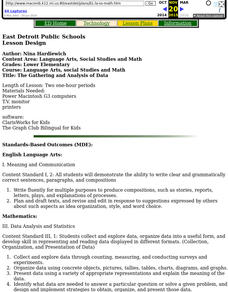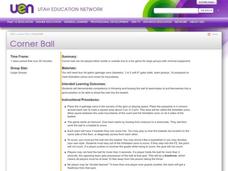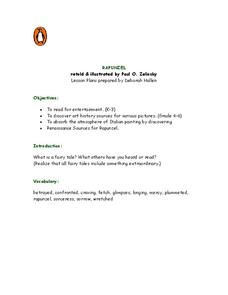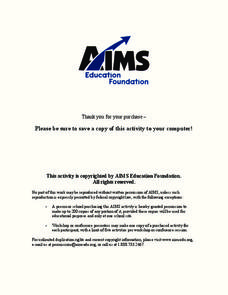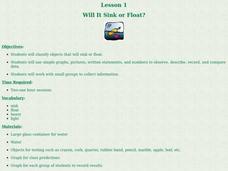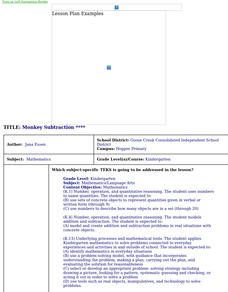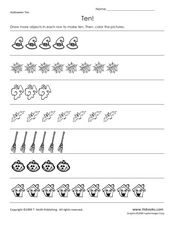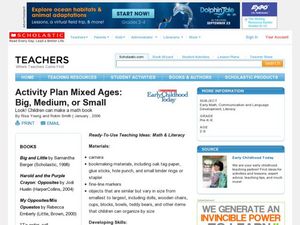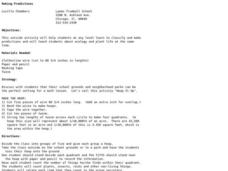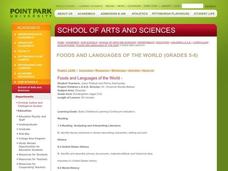Curated OER
Give Respect
Young learners explore what it means to be respectful. This resource includes a two page chart depicting rules for different settings at school such, as the cafeteria and the playground. What does following the rules look like? What does...
Curated OER
Math Practice-Grade 2
In this grade 2 math practice worksheet, students complete a set of 24 problems using a variety of grade 2 concepts. Answers are included.
Curated OER
Data Analysis, Probability, and Discrete Math
Choose to supplement your probability unit with this resource and you won't be disappointed with the outcome. Teach young mathematicians to organize information using tree diagrams and lists in order to determine the possible outcomes of...
Curated OER
William Shakespeare's Julius Caesar: Fate Versus Free Will
Students relate legends of lucky objects such as a rabbit's foot and principles of Feng Shui to fate and free will concepts that are expressed in Shakespeare's play, "Julius Casear". In small groups, they redesign the palace of Casear to...
Curated OER
The Gathering and Analysis of Data
Young mathematicians gather data on a topic, graph it in various forms, interpret the information, and write a summary of the data. They present their data and graphs to the class.
Curated OER
Corner Ball
Here's a game where players use a variety of ball handling skills. The players may not run when in possessioln of the ball, so it's like a big game of keep away. But there are goals, rather baskets, one in each corner of the gym. So the...
Curated OER
Rapunzel
Youngsters read the story of Rapunzel and go over vocabulary and answer discussion questions. They also list qualities of characters, discuss settings, make a diorama, and more.
Curated OER
Teaching Game Play Concepts
Some children with autism need to be prepped prior to game play, and game play concepts need to be introduced and reinforced. This short yet informative article will help you know how to get the kids in your special ed class ready for...
Mr Gym
Four Square
Here's your basic four square game. A short description of how to play the game as well as what constitutes a foul. If one commits a foul, then that player is out and goes to the end of the line. I recommend having more than one four...
Curated OER
Astronomy: Picture Time
Students investigate how to tell time by observing the placement of objects in the sky. Researching on the Internet, they locate the time for sunrise and sunset, the time the full moon rises, and the difference between clock and solar...
Curated OER
Bears Wear Buttons
Students practice counting sets of objects and numerals. In this numerical identification lesson, students listen to the story, Bears Wears Buttons, and participate in a flash card activity where students must place buttons on...
Alabama Learning Exchange
No More Money Trouble
Young consumers explore money identification and counting. In this cross-curricular money instructional activity, they participate in comprehension and writing activities prior to and after reading the book Money Trouble by Bill Cosby....
Curated OER
Will It Sink or Float?
Learners perform experiments to see if items will sink or float. For this sink or float lesson, students work in groups to make predictions, and record the results. After the experiments are complete learners make a book of the results.
Utah Education Network (UEN)
Picnic Field Day
Using laminated paper cookies, get your class exploring the concept of division. Read them One Hundred Hungry Ants, by Elino R.J. Princzes, and have learners model what is happening with toy plastic ants. There are many more fun...
Curated OER
Learning About Subtraction
In this learning about subtraction worksheet, students read and discuss the process and demonstrate understanding. In this problem solving worksheet, students produce ten differences.
Curated OER
Monkey Subtraction
Students listen to the book Five Little Monkeys Sitting In a Tree, identify written numbers 0-9 and the symbol for subtraction; students subtract two single digit numbers using manipulatives, and recite the corresponding number sentence.
T. Smith Publishing
Ten! A Halloween Worksheet
Boo! Little goblins count the Halloween-themed objects arranged in rows. They draw enough to bring each row to a total of 10. Use this when addressing the Common Core initiative in October with your kindergarten class.
Curated OER
Activity Plan Mixed Ages: Big, Medium, or Small
Students make a math book. In this early childhood math lesson plan, students develop language, observation, and math skills as they explore the sizes of objects and use cameras to take pictures for their own math booklet based on...
Curated OER
Making Predictions
Students collect and classify items. In this making predictions lesson, students go outside and collect specimens of plants, insects and minerals. They classify each item and place them in a Venn Diagram. Students compare and contrast...
Curated OER
Fraction Frenzy
Second graders identify fractions as part of a set. They explain concrete and symbolic representations of whole numbers, fractions, decimals, and percents in real-world situations. They complete a web-based cookie baking instructional...
Curated OER
Natural Selection Day 1
Young scholars define the concept of classification. In groups, they categorize a series of objects into categories they identify. As a class, they participate in a variety of activities to examine the concept of natural selection. To...
Curated OER
Foods and Languages of the World
Students study world cultures with an emphasis on languages and cultures. In this world cultures lesson, students study the countries of Spain, China, Italy, and the United States. Students read the story Everybody Cooks Rice and move...
Curated OER
Good Health
Students complete a unit with cross-curricular activities to learn about a healthy body and maintaining their health. In this health lesson, students complete 8 lessons to learn about good health, a healthy diet, healthy foods, healthy...
Curated OER
Story Starters
Students orally tell different types of stories using the assistance of props. For more advanced students, stories may be told according to a specific genre, or the story may have to include a given condition, setting, situation or theme.




